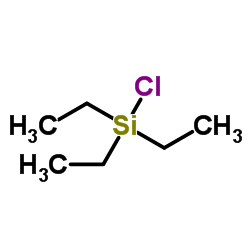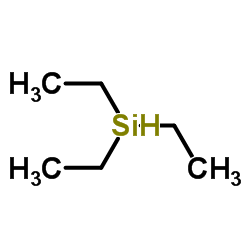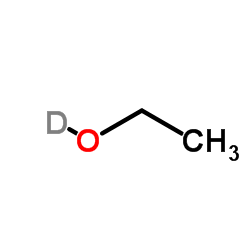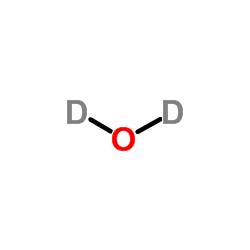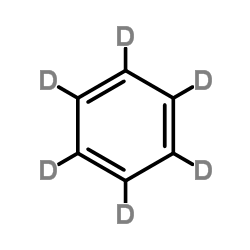1631-33-0
| 中文名 | 三乙基(硅烷-d) |
|---|---|
| 英文名 | deuterio(triethyl)silane |
| 英文别名 |
triethylsilane-d1
1-<2H1>-triethylsilane Triethyl(silane-d) MFCD01863535 deuterio-triethylsilane |
| 密度 | 0.737 g/mL at 25ºC(lit.) |
|---|---|
| 沸点 | 107ºC(lit.) |
| 分子式 | C6H15DSi |
| 分子量 | 117.28300 |
| 闪点 | 25 °F |
| 精确质量 | 117.10800 |
| LogP | 2.27320 |
| 折射率 | n20/D 1.4117(lit.) |
| 储存条件 | 常温 ,避光,通风干燥处 |
| 稳定性 | 常温常压下稳定 |
| 计算化学 | 1.疏水参数计算参考值(XlogP):无 2.氢键供体数量:0 3.氢键受体数量:0 4.可旋转化学键数量:3 5.互变异构体数量:无 6.拓扑分子极性表面积0 7.重原子数量:7 8.表面电荷:0 9.复杂度:25.7 10.同位素原子数量:1 11.确定原子立构中心数量:0 12.不确定原子立构中心数量:0 13.确定化学键立构中心数量:0 14.不确定化学键立构中心数量:0 15.共价键单元数量:1 |
| 更多 | 1. 性状:未确定 2. 密度(g/mL,15℃):0.737 3. 相对蒸汽密度(g/mL,空气=1):未确定 4. 熔点(ºC):未确定 5. 沸点(ºC,常压):107 6. 折射率:1.411 7. 闪点(ºC):未确定 8. 自燃点或引燃温度(ºC):未确定 9. 比旋光度(º): 未确定 10. 蒸气压(kPa,25ºC):未确定 11. 饱和蒸气压(kPa,60ºC):未确定 12. 燃烧热(KJ/mol):未确定 13. 临界温度(ºC):未确定 14. 临界压力(KPa):未确定 15. 油水(辛醇/水)分配系数的对数值:未确定 16. 爆炸上限(%,V/V):未确定 17. 爆炸下限(%,V/V):未确定 18. 溶解性:未确定 |
|
SECTION 1: Identification of the substance/mixture and of the company/undertaking Product identifiers Product name: Triethyl(silane-d) REACH No.: A registration number is not available for this substance as the substance or its uses are exempted from registration, the annual tonnage does not require a registration or the registration is envisaged for a later registration deadline.
CAS-No.: 1631-33-0 Relevant identified uses of the substance or mixture and uses advised against Identified uses: Laboratory chemicals, Manufacture of substances SECTION 2: Hazards identification Classification of the substance or mixture Classification according to Regulation (EC) No 1272/2008 Acute toxicity, Oral (Category 4), H302 Acute toxicity, Inhalation (Category 4), H332 Acute toxicity, Dermal (Category 4), H312 Skin irritation (Category 2), H315 Eye irritation (Category 2), H319 For the full text of the H-Statements mentioned in this Section, see Section 16. Classification according to EU Directives 67/548/EEC or 1999/45/EC F, Xn Highly flammable, Harmful R11, R20/21/22, R36/38 For the full text of the R-phrases mentioned in this Section, see Section 16. Label elements Labelling according Regulation (EC) No 1272/2008 Pictogram Signal wordWarning Hazard statement(s) H302Harmful if swallowed. H312Harmful in contact with skin. H315Causes skin irritation. H319Causes serious eye irritation. H332Harmful if inhaled. Precautionary statement(s) P280Wear protective gloves/ protective clothing. P305 + P351 + P338IF IN EYES: Rinse cautiously with water for several minutes. Remove contact lenses, if present and easy to do. Continue rinsing. Supplemental Hazardnone Statements Other hazards - none SECTION 3: Composition/information on ingredients Substances Chemical characterization : Isotopically labeled Synonyms: Deuterated triethylsilane Formula: C6DH15Si Molecular Weight: 117,28 g/mol CAS-No.: 1631-33-0 Hazardous ingredients according to Regulation (EC) No 1272/2008 ComponentClassificationConcentration Triethyl(silane-d) CAS-No.1631-33-0Acute Tox. 4; Skin Irrit. 2; Eye <= 100 % Irrit. 2; H302 + H312 + H332, H315, H319 For the full text of the H-Statements and R-Phrases mentioned in this Section, see Section 16 SECTION 4: First aid measures Description of first aid measures General advice Consult a physician. Show this safety data sheet to the doctor in attendance. If inhaled If breathed in, move person into fresh air. If not breathing, give artificial respiration. Consult a physician. In case of skin contact Wash off with soap and plenty of water. Consult a physician. In case of eye contact Rinse thoroughly with plenty of water for at least 15 minutes and consult a physician. If swallowed Never give anything by mouth to an unconscious person. Rinse mouth with water. Consult a physician. Most important symptoms and effects, both acute and delayed The most important known symptoms and effects are described in the labelling (see section 2.2) and/or in section 11 Indication of any immediate medical attention and special treatment needed no data available SECTION 5: Firefighting measures Extinguishing media Suitable extinguishing media Use water spray, alcohol-resistant foam, dry chemical or carbon dioxide. Special hazards arising from the substance or mixture no data available Advice for firefighters Wear self contained breathing apparatus for fire fighting if necessary. Further information no data available SECTION 6: Accidental release measures Personal precautions, protective equipment and emergency procedures Use personal protective equipment. Avoid breathing vapours, mist or gas. Ensure adequate ventilation. For personal protection see section 8. Environmental precautions Do not let product enter drains. Methods and materials for containment and cleaning up Soak up with inert absorbent material and dispose of as hazardous waste. Keep in suitable, closed containers for disposal. Reference to other sections For disposal see section 13. SECTION 7: Handling and storage Precautions for safe handling Avoid contact with skin and eyes. Avoid inhalation of vapour or mist. For precautions see section 2.2. Conditions for safe storage, including any incompatibilities Store in cool place. Keep container tightly closed in a dry and well-ventilated place. Store under inert gas. hygroscopic Specific end use(s) A part from the uses mentioned in section 1.2 no other specific uses are stipulated SECTION 8: Exposure controls/personal protection Control parameters Components with workplace control parameters Exposure controls Appropriate engineering controls Handle in accordance with good industrial hygiene and safety practice. Wash hands before breaks and at the end of workday. Personal protective equipment Eye/face protection Face shield and safety glasses Use equipment for eye protection tested and approved under appropriate government standards such as NIOSH (US) or EN 166(EU). Skin protection Handle with gloves. Gloves must be inspected prior to use. Use proper glove removal technique (without touching glove's outer surface) to avoid skin contact with this product. Dispose of contaminated gloves after use in accordance with applicable laws and good laboratory practices. Wash and dry hands. The selected protective gloves have to satisfy the specifications of EU Directive 89/686/EEC and the standard EN 374 derived from it. Body Protection Complete suit protecting against chemicals, The type of protective equipment must be selected according to the concentration and amount of the dangerous substance at the specific workplace. Respiratory protection Where risk assessment shows air-purifying respirators are appropriate use a full-face respirator with multi-purpose combination (US) or type ABEK (EN 14387) respirator cartridges as a backup to engineering controls. If the respirator is the sole means of protection, use a full-face supplied air respirator. Use respirators and components tested and approved under appropriate government standards such as NIOSH (US) or CEN (EU). Control of environmental exposure Do not let product enter drains. SECTION 9: Physical and chemical properties Information on basic physical and chemical properties a) AppearanceForm: liquid b) Odourno data available c) Odour Thresholdno data available d) pHno data available e) Melting point/freezingno data available point f) Initial boiling point and 107 °C at 1.013 hPa boiling range g) Flash pointno data available h) Evapouration rateno data available i) Flammability (solid, gas) no data available j) Upper/lowerno data available flammability or explosive limits k) Vapour pressureno data available l) Vapour densityno data available m) Relative density0,737 g/mL at 25 °C0,737 g/cm3 at 25 °C n) Water solubilityno data available o) Partition coefficient: n- no data available octanol/water p) Auto-ignitionno data available temperature q) Decompositionno data available temperature r) Viscosityno data available s) Explosive propertiesno data available t) Oxidizing propertiesno data available Other safety information no data available SECTION 10: Stability and reactivity Reactivity no data available Chemical stability Stable under recommended storage conditions. Possibility of hazardous reactions no data available Conditions to avoid no data available Incompatible materials Strong oxidizing agents Hazardous decomposition products Other decomposition products - no data available In the event of fire: see section 5 SECTION 11: Toxicological information Information on toxicological effects Acute toxicity no data available Skin corrosion/irritation no data available Serious eye damage/eye irritation no data available Respiratory or skin sensitisation no data available Germ cell mutagenicity no data available Carcinogenicity IARC:No component of this product present at levels greater than or equal to 0.1% is identified as probable, possible or confirmed human carcinogen by IARC. Reproductive toxicity no data available Specific target organ toxicity - single exposure no data available Specific target organ toxicity - repeated exposure no data available Aspiration hazard no data available Additional Information RTECS: Not available To the best of our knowledge, the chemical, physical, and toxicological properties have not been thoroughly investigated. SECTION 12: Ecological information Toxicity no data available Persistence and degradability no data available Bioaccumulative potential no data available Mobility in soil no data available Results of PBT and vPvB assessment PBT/vPvB assessment not available as chemical safety assessment not required/not conducted Other adverse effects no data available SECTION 13: Disposal considerations Waste treatment methods Product Offer surplus and non-recyclable solutions to a licensed disposal company. Contaminated packaging Dispose of as unused product. SECTION 14: Transport information UN number ADR/RID: 1993IMDG: 1993IATA: 1993 UN proper shipping name ADR/RID: FLAMMABLE LIQUID, N.O.S. (Triethyl(silane-d)) IMDG: FLAMMABLE LIQUID, N.O.S. (Triethyl(silane-d)) IATA:Flammable liquid, n.o.s. (Triethyl(silane-d)) Transport hazard class(es) ADR/RID: 3IMDG: 3IATA: 3 Packaging group ADR/RID: IIIMDG: IIIATA: II Environmental hazards ADR/RID: noIMDG Marine pollutant: noIATA: no Special precautions for user no data available SECTION 15: Regulatory information This safety datasheet complies with the requirements of Regulation (EC) No. 1907/2006. Safety, health and environmental regulations/legislation specific for the substance or mixture no data available Chemical Safety Assessment For this product a chemical safety assessment was not carried out SECTION 16: Other information Full text of H-Statements referred to under sections 2 and 3. Acute Tox.Acute toxicity Eye Irrit.Eye irritation H302Harmful if swallowed. H302 + H312 +Harmful if swallowed, in contact with skin or if inhaled H332 H312Harmful in contact with skin. H315Causes skin irritation. Full text of R-phrases referred to under sections 2 and 3 R11Highly flammable. R20/21/22Harmful by inhalation, in contact with skin and if swallowed. R36/38Irritating to eyes and skin. Further information Copyright 2013 Co. LLC. License granted to make unlimited paper copies for internal use only. The above information is believed to be correct but does not purport to be all inclusive and shall be used only as a guide. The information in this document is based on the present state of our knowledge and is applicable to the product with regard to appropriate safety precautions. It does not represent any guarantee of the properties of the product. Corporation and its Affiliates shall not be held liable for any damage resulting from handling or from contact with the above product. See and/or the reverse side of invoice or packing slip for additional terms and conditions of sale. |
|
生态学数据: 通常对水是不危害的,若无政府许可,勿将材料排入周围环境
|
| 符号 |

GHS07 |
|---|---|
| 信号词 | Warning |
| 危害声明 | H302-H312-H315-H319-H332 |
| 警示性声明 | P280-P305 + P351 + P338 |
| 危害码 (欧洲) | F,Xn |
| 风险声明 (欧洲) | 11-20/21/22-36/38 |
| 安全声明 (欧洲) | 16-26-36/37/39-51 |
| 危险品运输编码 | UN 1993 3/PG 2 |
|
~60% 
1631-33-0 |
| 文献:Caseri, W.; Pregosin, P. S. Journal of Organometallic Chemistry, 1988 , vol. 356, p. 259 - 270 |
|
~64% 
1631-33-0 |
| 文献:Brown, John M.; Lloyd-Jones, Guy C. Journal of the American Chemical Society, 1994 , vol. 116, # 3 p. 866 - 878 |
|
~97% 
1631-33-0 |
| 文献:Campos, Jesus; Rubio, Miguel; Esqueda, Ana C.; Carmona, Ernesto Journal of Labelled Compounds and Radiopharmaceuticals, 2012 , vol. 55, # 1 p. 29 - 38 |
|
~% 
1631-33-0 |
| 文献:Corriu, R. J. P .; Guerin, C.; Kolani, B. Bulletin de la Societe Chimique de France, 1985 , # 5 p. 973 - 979 |
|
~% 
1631-33-0 |
| 文献:Gmelin Handbook: Si: MVol.C, 34, page 106 - 108 |
|
~0% 
1631-33-0 |
| 文献:Khaskin, I. G. Zhurnal obshchei Khim. (russ.), 1953 , vol. 23, p. 32 - 37 C. A., 1954 , p. 563 Full Text Show Details Gmelin Handbook: Si: MVol.C, 34, page 106 - 108 |
|
~0% 
1631-33-0 |
| 文献:Khaskin, I. G. Zhurnal obshchei Khim. (russ.), 1953 , vol. 23, p. 32 - 37 C. A., 1954 , p. 563 Full Text Show Details Gmelin Handbook: Si: MVol.C, 34, page 106 - 108 |
|
~0% 
1631-33-0 |
| 文献:Khaskin, I. G. Zhurnal obshchei Khim. (russ.), 1953 , vol. 23, p. 32 - 37 C. A., 1954 , p. 563 Full Text Show Details Gmelin Handbook: Si: MVol.C, 34, page 106 - 108 |
|
~% 
1631-33-0 |
| 文献:Mochida, Kunio; Takeuchi, Hidenori; Hiraga, Yoo; Ogawa, Hiroyasu Chemistry Letters, 1984 , p. 1989 - 1992 |


